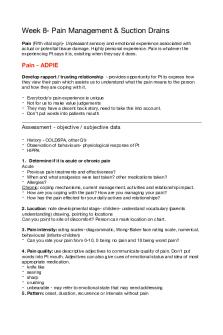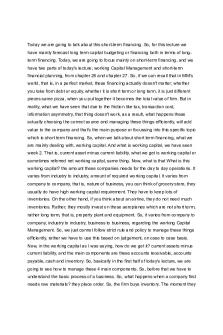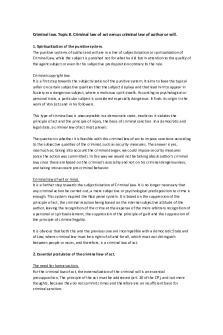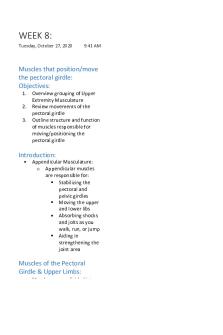Notes on Lecture 8 - London PDF

| Title | Notes on Lecture 8 - London |
|---|---|
| Author | Orla Mair |
| Course | Topics in music history before 1750 |
| Institution | The Chancellor, Masters, and Scholars of the University of Cambridge |
| Pages | 7 |
| File Size | 310.3 KB |
| File Type | |
| Total Downloads | 58 |
| Total Views | 137 |
Summary
Lecture about early modern music making practices in London, given by lecturer Bettina Varwig in March 2021 at University of Cambridge...
Description
-
1724 Castration was made illegal by the Papal states in 1870 - the last place in Europe to rule it out officially We can’t fully reconstruct the sound of the castrati these days
-
In 17th C London, the castrati were still a very common sight and sound on stage: they were the celebrated superstars of Italian opera and their unique sound qualities left critics and audiences completely enraptured
-
From 1714 London experienced a rapid expansion: new quarters of the city built, like Mayfair for the wealthy upper classes Economic boom was underpinned by the colonial economy, incorporated slave labour and the sugar trade, based around British colonial possessions in the West Indies Around 1700, the urban geography of London was defined by the cataclysmic event of 1666 (Great Fire of London) About 60% of the city had been destroyed in that fire and had to be rebuilt from scratch
-
-
-
-
-
New St Paul’s cathedral after the old one burned: designed by Sir Christopher Wren, and declared completed by Parliament in 1711 - year of Vivaldi’s L’Estro Armonico St Paul’s stood on the highest point of the city and was the tallest building in the city until 1967 Was the seat of the Anglican bishop of London and a centre of sacred music making in the city, alongside Westminster Abbey, where coronations etc took place London Bridge: only bridge over the river until early 18th C Westminster Bridge opened in 1750, Tower Bridge not until the 19th C This urban expansion and the gentrification that went with it (the growth of the wealthy bourgeoisie) made for a crowd of avid theatre goers and by the early 18th C, London had about 700,000 inhabitants Various theatres serving that crowd, presented various types of entertainment from plays and pantomimes to full-blown opera The King’s Theatre, Haymarket: where most of Handel’s operas took place These opera performances were generally reserved for the wealthier classes, steep ticket prices But, there were some cheaper seats in the upper galeries of the theatre as well Italian opera had arrived in London during the 1710-11 season with Handel’s Rinaldo and the royals started attending the opera when George I ascended the throne in 1714 1719: First Royal Academy of Music was established by aristocrats to foster opera in the city - this has no connection to the current RAM, which was founded in 1822 Original proposal to the city council: “Opera’s are the most harmless of all publick Diversions. They are an Encouragement and Support to an art that has been cherished by all Polite Nations. They carry along with them some Marks of Publick Magnificence and are the great Entertainment which Strangers share in. Therefore it seems very strange that this great and opulent City hath not been able to support Publick Spectacles of this Sort for any considerable time…”
-
-
-
A company run by subscription: the subscribers included some of the most highlyplaced names in the Kingdom: Lord Burlington, Lord Chandos Many of their contributions were underpinned by investments in colonial trading companies, including the Royal African Company (official British slave trading company) - handel invested in it in the 1720s - and the South Sea Company (founded in 1711 as a stock company for supplying African slaves to England’s South American colonies) Despite an initial collective investment of over £10,000 from its subscribers, this RAM ran into financial difficulties that plagued the operatic business: very costly business (constant new works, new productions, set designs, rehearsal time, exorbitant salaries for the star singers) By 1728, this company was out of business and replaced by other similar ventures 3 main composers who contributed to RAM’s opera schedule in the 1720s: Handel, Bononcini and Ariosti (German, Italian, Italian) All of them foreigners, although Handel eventually started an oratorio tradition that lay the foundation for a quintessentially English musical culture A bit like Lully in Paris
-
20th Feb 1724: premiere of Handel’s Giulio Cesare at the King’s Theatre That theatre was established in 1705 and was London's principal opera house - more than 25 Handel operas had their premiere here Rinaldo (first one) gained him instant fame Handel later became joint director of the King’s Theatre in 1729, when RAM had to collapse Giulio Cesare had 13 initial performances there and then 10 more in the following season: successful Also staged in Hamburg and Paris
-
Plenty of action and excitement and confusion
-
-
The repertoire of Baroque opera stages some distinct challenges for performing them today: they are in Italian and because of these convoluted plots Directors and audiences now tend to struggle with that formulaic succession of recits and static da capo arias The acting was apparently very stilted - actors expected to hold poses of sadness etc while delivering arias - the dap capo aria explores 1 emotional state
-
-
-
-
Strict conventions governing the dramatic action more generally (good people enter from stage right and bad from stage left) These formalities don’t tend to sit so well with modern audiences expectations for a fluid and realistic theatrical spectacle Also, set designs weren’t spectacular: one place to save money, so often stock backdrops, like garden, castle, which could then be reused between different operas and productions What did people in the early 18th C come to see at the opera house? Most of the money was spent on the star singers, and their vocal virtuosity was one of the key things people came to see, still the case with many audiences today So the dramatic structure of these works is designed to enable maximum vocal display from those soloists, then singers usually exit after an aria, allowing for applause, then they could return for repeat of the same number, and so on In Giulio Cesare, the first aria was for Caesar, and he was played by the celebrated castrato Senesino at the premiere Famous female soprano: Francesca Cuzzoni played main female protagonist (Cleopatra) Both singers were from Italy and both had international careers Cuzzoni was born in Palma, had her Venetian debut in 1718, then came to London in 1723 to sing in Handel’s opera Ottone She was the undisputed sop star of the London opera stage until 1726, when Faustina Bordoni arrived on the scene (Italian) When she came to London, a rivalry developed between her and Cuzzoni, and apparently they ended up punching each other on stage during a performance of an opera by Boloncini - great scandal Played out in the public sphere - rivalry carried on by groups of public supporters through polemics and the newspapers etc Their rivalry is also caricatured later on in John Gay’s Beggar’s Opera of 1728
-
Castrato singers: Distinctive physical attributes of the castrati: broad chest and long limbs - towering over the other actors The castrato has to been seen as a central force of 18th C operatic life: metaphor for
-
the loss of this sound world more broadly, the listening habits, the behaviours, the forms of musical expression are all quite distant from us and hard to access If we’re trying to reimagine Italian opera in London at the time, we are faced with all of those aspects, but the particular sonic qualities of the castrato crystallise that loss
-
Castrati first appeared in Italy in the mid-16th century Women weren’t allowed to sing in church (they were to be silent)
-
Production of male hormones was greatly reduced
-
-
-
Castrati were also central to the earliest developments of opera In Monteverdi’s Orfeo, it was a castrato who sung the part of Esperanza (Hope) and also perhaps Iridice And by the 1680s, they had more or less supplanted other male voices in the lead roles - they became the first operatic superstars Farinelli and Seresino Often children from poor backgrounds who could hope to make money and a career from their singing Haydn and Rossini tell of their narrow escapes from being castrated early in life Once they gained fame, they commanded very large fees and frenzied public acclaim The 1720s and 30s saw the high point of that craze for the operatic castrato Bernacchi also sang in some of Handel’s operas in London Then, after the 1730s, the castrato tradition slowly declined and they were eventually replaced by heroic tenors in much 19th C operatic repertoire Castrati’s high voices came to be regarded as symbols of heroic male virtue, ironically The castrato craze invited us to reconsider our conceptions of masculinity, reminds us that in the early modern period, the 2 sexes were thought of not as polar opposites but more on a continuum with the female regarded primarily as a lesser version of male sexuality They were colder and therefore didn’t develop the sexual prowess that men did
-
-
-
-
-
Castrati occupied a middle ground between the 2 sexes, but were clearly identified as men, and there was no problem with them taking on male heroic roles They were also sexually appealing to both men and women - to women because intercourse couldn’t make her pregnant A gender fluidity being acted out in the theatrical realm here that also encompassed women playing male roles So this practice marks opera out as an extremely queer artform from the very beginning of its traditions and in that it has the power to challenge gender norms, both now and then in different ways Nowadays, productions of Baroque operas use countertenors or female performers to perform those castrato roles 1994 film Farinelli - recreates a castrato sound by digitally merging a countertenor and soprano voice How do we try and recreate these historical sounds, works and performances now? How do you put on a Handel opera today? Recreate the original? Or update it - make the themes speak to contemporary audiences? How do we imagine this historical period? Almira - Handel’s first opera - 1705 Historically-informed performance as we envisage it from the sources we have: posturing (standing still and delivering lines), historical costumes, funny hand position - taken from historical acting manuals How far do you go? There wouldn’t have been electric lighting. What about audience behaviour (eating and clapping etc) Generally abides by modern day concert culture but the costumes etc are historical HIP movement has pushed us in the direction of playing 17th C music in an historically-informed way, but most directors opt not to go for the full 18th C costumes wigs etc - most will follow the early 20th C tradition of Regietheater (came from Wagner) - director devises a staging that imprints their own vision of the piece (often abstract, current political issues, sets a place and time that might not correspond to the setting of the opera) Interesting layers: in Handel’s time, the story of Greek characters was removed in time, and related to 18th C politics, and now we’re reworking it again Giulio Cesare - 2005 Glyndebourne production set in colonised Egypt (issues of power relations - hypocrisies of colonial conquest) Aria ‘Empio, dirò, tu sei’ - Caesar breaks into a rage aria Caesar was originally a castrato role, but now sung by a woman, but dressed like a man Original print of the opera: affective anger created by C minor, fast runs, repeated notes in strings, diminished intervals (gets the heart rate up) Opening ritornello built on vordersatz, which leads to modulatory section, then a cadential confirmation that lands back in Cm The idea of the ritornello as a structuring element reaches across genres (concerti, da capo aria) Descending scale in unison as a means of displaying what the key is Original castrato had a limited range, but was virtuosic within his range
-
-
-
-
-
-
-
-
-
-
Productions were created in the moment with people who were there, and then in revivals, arias were replaced based on the singers who were there, so most of these arias were general rage arias, love arias Da capo aria: orchestral ritornello, then ABA structure: had a long life in opera: appeal was the return of the A section, allowing singer to shine in terms of ornamentation, and unified moment of emotion (A sections bracketing a middle section but creating continuity of affect, and prospect for growth) In this aria, the B section uses materials of the A section, so it’s all encompassing anger The woman takes a very masculine stance: contrasts Cleopatra (exoticism, feminism) In original production, Cleo was played by a soprano First aria: puts Cleopatra on the scene as a powerful woman, who’s in charge, manipulative (talking about how she’s going to seduce Caesar) - draws on this idea of stylised gesture, but with Bollywood inspired dance moves (exoticism) Her central aria comes at the beginning of act 2: seduction scene - she’s in disguise (stock operatic trick) - on stage ensemble (creates frame within a frame, where we’re alerted to the fact that this is a set piece, with Caesar as the audience to this mini opera that’s going on) On-stage ensemble: the muses playing with this ancient trope with the power of music - distant strange sound world (theorbo, viola de gambas) - sense of this happening in its own separate bubble Da capo aria as a freezeframe moment End of B section: before the A section, Caesar interjects with recit - interesting moment - stages this conventional form of the da capo aria, but those expectations are disrupted in a way that breaks the frame that’s being created Presupposes an audience who know these conventions, and plays with audience expectations Both of these arias were included in a 1725 collection of favourite songs from the opera - pocketbook that could be used for domestic performances Texts in Italian, but with English translations Opera spilling out into other spheres (domestic music making) The publishers also published in 1725, ‘the whole opera’ although it was only the overture and arias, and some dances, wasn’t intended to enable future performances (outdoor music making and domestic music making) - no recit The full score only survives in manuscript Arias became popular song - continuum from opera scores to songbooks to more easily accessible single songsheets A lot of popular songs had very topical themes (lamenting Senesino’s departure from London) - could form part of a high art culture in aristocratic salons, but could also become part of a more popular song culture more generally - parody of excessive fan culture that surrounded these operatic superstars Beggar’s Opera - 1728 by John Gay The First musical or ballad opera: ballade opera with songs interspersed, no recit Songs arranged by Johann Christoph Pepusch Pastiche - cut and paste of different snippets of religious hymns and excerpts from
-
-
-
-
-
-
-
-
operas of the time Premiered at the Lincoln’s Inn Fields Theatre Had 62 runs so very very popular from people from all social classes Weak plotline: satire of cultural world of Georgian London (notorious for high crime rates and corruption and exploitation in the upper classes) - addresses some of these social inequalities - juxtaposes thieves with aristocrats Music made up of street songs and excerpts from opera arias etc, so the audience could hum along Melody of Greensleeves with new words (Upon Tyburn tree - where people were hanged) - protagonist wondering why so few rich people were being hanged when supposedly the law should apply to everyone Simple musical arrangement - appeal of drawing people in, getting words across in a way that people could relate to Female protagonist (Lavinia Fenton) was a lower class person, a prostitute, a barmaid, then became the most talked-about stage personality in London for her role in the Beggar’s Opera Wealthy audience members could buy seats on stage - interesting intermingling between theatre and real life - caricaturing what’s going on in real life outside opera doors - it had very tangible connections to what was going on in real life London March from Handel’s Rinaldo taken to form a bit of Act II - instrumental march that words have been added to Intertextuality - blending of high art styles with popular idioms These different musical idioms were usually separated by the venues they were performed at, but in this opera, they collided audibly - drew people in in a way that no other artform of the time could ‘The Enraged Musician’ - collision of sound worlds - chaos of street life crashing in through the window of this upper class man, where ‘nice’ music is trying to be made The Beggar’s Opera is a pastiche - comments on worlds of high and low, commercial and aesthetic and gives a good idea of what was going on in musical culture in London at the time and brings audiences together from a broader spectrum of social classes Handel opera was only one slice of what was going on in London at the time - very few could understand the Italian, or afford tickets Beggar’s Opera doesn’t tear down those boundaries, but commented on them None of these different spheres of music making can be looked at in isolation Opera wasn’t esoteric - it spills outwards and informs other spheres What other theatre, domestic music making, and pleasure gardens music making was going on Intermingling of different strata needs to be taken into account when we think about each of them individually Evolving public sphere: newspapers and public discussion of music - started shaping music production and musical taste - emerging interest in music, theatre, arts as a topic to be discussed The Spectator Newspaper was established in 1711...
Similar Free PDFs

Notes on Lecture 8 - London
- 7 Pages

8 - Lecture notes 8
- 21 Pages

8 - Lecture notes 8
- 21 Pages

8 Midwifery - Lecture notes 8
- 3 Pages

Taxation 8 - Lecture notes 8
- 2 Pages

Week 8 - Lecture notes 8
- 6 Pages

Dox 8 - Lecture notes 8
- 21 Pages

Lesson 8 - Lecture notes 8
- 2 Pages

Assignment 8 - Lecture notes 8
- 4 Pages

Week 8 - Lecture notes 8
- 23 Pages

WEEK 8 - Lecture notes 8
- 10 Pages

CL-8 - Lecture notes 8
- 12 Pages

Tema 8 - Lecture notes 8
- 8 Pages

Lesson 8 - Lecture notes 8
- 19 Pages

Chapter 8 - Lecture notes 8
- 7 Pages

Chapter 8 - Lecture notes 8
- 2 Pages
Popular Institutions
- Tinajero National High School - Annex
- Politeknik Caltex Riau
- Yokohama City University
- SGT University
- University of Al-Qadisiyah
- Divine Word College of Vigan
- Techniek College Rotterdam
- Universidade de Santiago
- Universiti Teknologi MARA Cawangan Johor Kampus Pasir Gudang
- Poltekkes Kemenkes Yogyakarta
- Baguio City National High School
- Colegio san marcos
- preparatoria uno
- Centro de Bachillerato Tecnológico Industrial y de Servicios No. 107
- Dalian Maritime University
- Quang Trung Secondary School
- Colegio Tecnológico en Informática
- Corporación Regional de Educación Superior
- Grupo CEDVA
- Dar Al Uloom University
- Centro de Estudios Preuniversitarios de la Universidad Nacional de Ingeniería
- 上智大学
- Aakash International School, Nuna Majara
- San Felipe Neri Catholic School
- Kang Chiao International School - New Taipei City
- Misamis Occidental National High School
- Institución Educativa Escuela Normal Juan Ladrilleros
- Kolehiyo ng Pantukan
- Batanes State College
- Instituto Continental
- Sekolah Menengah Kejuruan Kesehatan Kaltara (Tarakan)
- Colegio de La Inmaculada Concepcion - Cebu